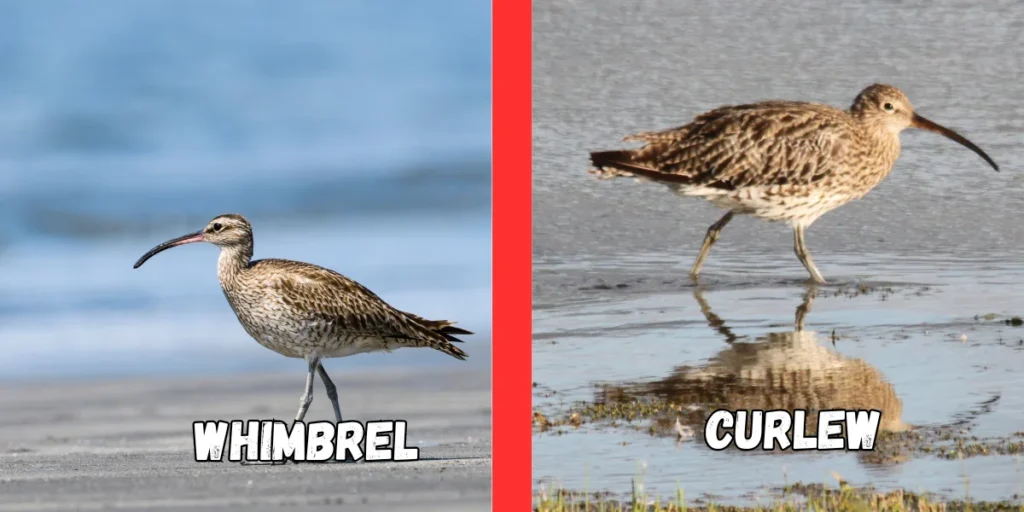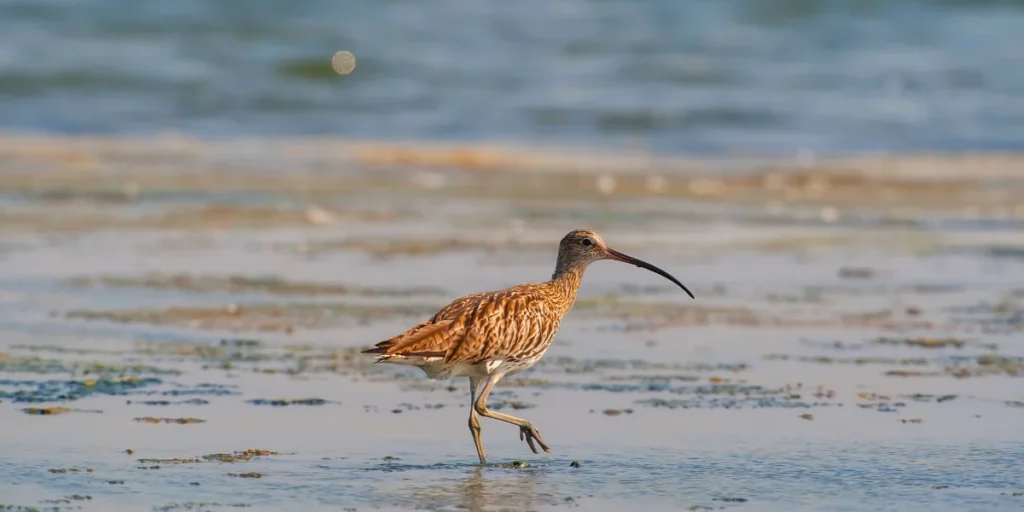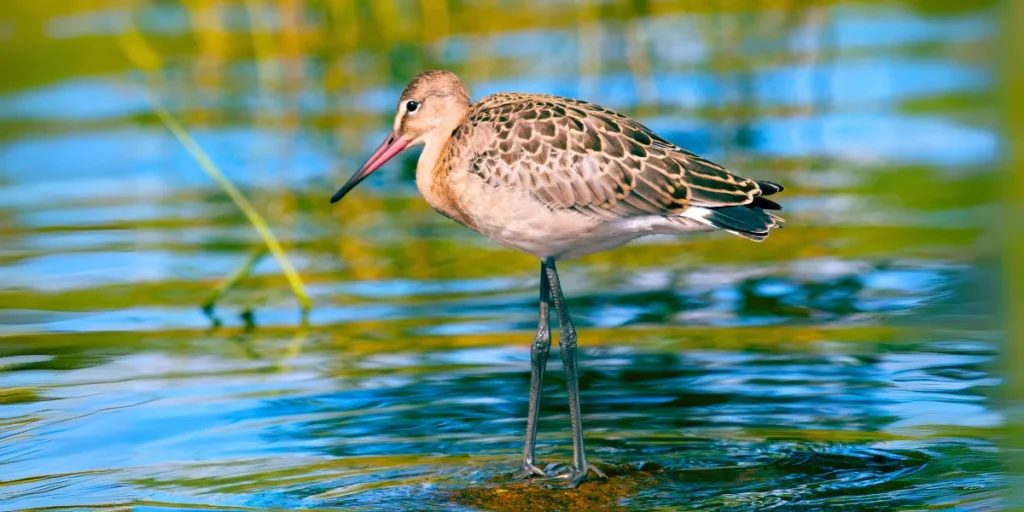Whimbrels and curlews are two types of birds that live near water, often in muddy or sandy areas. At first glance, they might look very similar because both have long, curved beaks and brown feathers. However, there are many differences between these birds. In this guide, we’ll explain how to tell them apart, where they live, what they eat, and why they are important.
How to Tell Whimbrels and Curlews Apart
Though both birds look alike, there are some key differences in their size, beak shape, and patterns on their feathers.
- Size: Whimbrels are smaller than curlews. A whimbrel is about the size of a crow, while a curlew is bigger, closer in size to a small hawk.
- Beak: Whimbrels have shorter, slightly curved beaks, while curlews have very long and deeply curved beaks. The curlew’s beak is great for digging into mud for food.
- Feathers: Whimbrels have streaked brown feathers and a pale stripe on their heads. Curlews are more plain, with brown feathers that are less streaky and no stripe on their heads.
| Feature | Whimbrel | Curlew |
|---|---|---|
| Size | Smaller (37–47 cm) | Larger (50–60 cm) |
| Beak | Short, slightly curved | Long, deeply curved |
| Feathers | Streaked, with a head stripe | Plain, no head stripe |

Where Whimbrels and Curlews Live
Whimbrels and curlews both like areas near water, but they don’t always live in the exact same places.
- Whimbrels: They live on beaches, mudflats, rocky shores, and sometimes grassy wetlands. During their migration (traveling between warm and cold places), they can also be found inland. Whimbrels breed in cold Arctic regions but travel thousands of kilometers to warmer places like Africa, South America, and Asia during winter.
- Curlews: These birds live in more places than whimbrels. Some curlews live near the coast, while others live in grasslands, moors, and fields. Curlews breed in Europe, Asia, and North America and migrate to southern Europe, Africa, and Asia for the winter.
What They Eat
Both birds use their long beaks to find food in mud, sand, or grass, but they eat slightly different things.
- Whimbrels: They eat small creatures like crabs, worms, and insects. Sometimes, they eat small fish or berries.
- Curlews: Curlews eat a variety of food, such as worms, crabs, shrimp, and sometimes frogs. Their long beaks allow them to dig deep into the ground for food.
| Diet | Whimbrel | Curlew |
|---|---|---|
| Main Foods | Crabs, worms, insects, berries | Worms, crabs, shrimp, frogs |
| Feeding Depth | Shallow mud or sand | Deeper mud or soft soil |
How They Travel
Both birds migrate, which means they travel long distances between where they breed and where they spend the winter.
- Whimbrels: These birds are amazing travelers. They can fly thousands of kilometers, stopping on beaches to rest and eat along the way.
- Curlews: Curlews also migrate, but the distance depends on the species. Some fly short distances, while others travel as far as Africa.
Nesting and Babies
Whimbrels and curlews both build nests on the ground in open areas.
- Whimbrels: They make their nests in the Arctic, using grass and moss to line a small hole in the ground. They lay 3–5 eggs, and both parents take turns keeping the eggs warm.
- Curlews: Curlews also make nests on the ground, often in grasslands or wetlands. They usually lay 3–4 eggs. Like whimbrels, both parents help care for the eggs and chicks.
Why Whimbrels and Curlews Are Important
These birds are very important for the environment.
- Control Insects: By eating worms, crabs, and insects, they help keep these populations under control.
- Improve Soil: When they dig in the mud or soil with their beaks, they make the ground healthier by mixing it up.
- Food for Other Animals: Larger animals, like hawks, eat whimbrels and curlews, making them part of the food chain.
Are These Birds in Danger?
Whimbrels are not in serious danger yet, but their homes are being destroyed by human activities like building and farming. They are listed as Least Concern, but their numbers could drop if we don’t protect their habitats.
Curlews are in more trouble:
- The Eurasian curlew is listed as Near Threatened because their numbers are decreasing due to hunting and habitat loss.
- The long-billed curlew is doing better but still faces challenges like farmland development.
- The slender-billed curlew is critically endangered and might already be extinct.
Fun Facts
- Whimbrels can eat crabs whole by crushing their shells with their strong beaks.
- Curlews have one of the longest beaks in the bird world.
- Both birds use their calls to communicate. A curlew’s call is loud and flute-like, while a whimbrel’s is sharper and more repetitive.
Quick Comparison Table
| Feature | Whimbrel | Curlew |
|---|---|---|
| Size | Smaller (37–47 cm) | Larger (50–60 cm) |
| Beak | Short, slightly curved | Long, deeply curved |
| Feathers | Streaked, with a head stripe | Plain, no head stripe |
| Diet | Crabs, worms, insects | Worms, shrimp, frogs |
| Habitats | Beaches, mudflats, wetlands | Grasslands, moors, coastlines |
| Migration | Long-distance | Varies by species |
Types of Whimbrels
Whimbrels (Numenius phaeopus) are medium-sized birds found in different parts of the world. There are several types, or subspecies, of whimbrels, and each one has small differences in size, looks, and where they live. Below is an easy-to-understand explanation about their size, diet, and other important details.
1. European Whimbrel (Numenius phaeopus phaeopus)
- Size:
- Length: 37–45 cm
- Wingspan: 75–90 cm
- Weight: 270–450 grams
- Diet:
- They eat worms, insects, small shellfish, and crustaceans.
- During migration, they also eat berries.

Description:
The European whimbrel lives in northern Europe, such as Iceland and Scandinavia, during the breeding season. When winter comes, these birds fly to warmer places like southern Europe, Africa, and parts of the Middle East. They prefer to live in places like mudflats, sandy beaches, and tidal areas where they can find food. The European whimbrel has brown streaked feathers and a pale stripe on its head that helps it blend into its surroundings.
2. Siberian Whimbrel (Numenius phaeopus variegatus)
- Size:
- Length: 40–46 cm
- Wingspan: 78–95 cm
- Weight: 300–490 grams
- Diet:
- They mainly eat small crustaceans, marine worms, and insects.
- They also eat seeds and some plant matter.

Description:
The Siberian whimbrel lives in Siberia during the summer and migrates to Southeast Asia, Australia, and the Pacific Islands during the winter. These birds are a little darker than the European long-billed bird. They like to live in coastal areas like wetlands and beaches where they can find food easily.
3. Hudsonian Whimbrel (Numenius phaeopus hudsonicus)
- Size:
- Length: 40–47 cm
- Wingspan: 80–100 cm
- Weight: 290–510 grams
- Diet:
- They feed on marine worms, mollusks (small shellfish), and small crabs.
- They also eat berries and seeds sometimes.

Description:
Hudsonian whimbrels are found in North America. They breed in the Arctic and migrate to places like Central and South America during the winter. They are darker than the other types of long-billed birds and prefer to live in coastal mudflats and marshes. These birds can often be seen walking along the shore looking for food.
Types of Curlews
Curlews are large, long-legged shorebirds with distinctive long, curved beaks. There are a few different types of curlews, and each one has some differences in size, diet, and where they live. Below is an easy-to-understand explanation about the different types of curlews and their characteristics.
1. Eurasian Curlew (Numenius arquata)
- Size:
- Length: 48–61 cm
- Wingspan: 89–106 cm
- Weight: 550–1,000 grams
- Diet:
- They eat worms, insects, mollusks, and small crustaceans.
- They also sometimes eat berries and seeds.

Description:
The Eurasian curlew is found in Europe, Asia, and parts of the Middle East. They like to live in coastal areas, wet meadows, and mudflats where they can find their food. These birds are large with long legs and a very long, downward-curved bill, which helps them dig for food in the mud. In the winter, they migrate to warmer areas like southern Europe, Africa, and the Middle East.
2. Long-billed Curlew (Numenius americanus)
- Size:
- Length: 50–60 cm
- Wingspan: 95–105 cm
- Weight: 400–750 grams
- Diet:
- They mainly feed on worms, insects, and small mollusks.
- They also eat some seeds and berries during migration.

Description:
The Long-billed curlew is found in North America. They have the longest bill of any curlew, which they use to probe deep into the ground for food. They live in grasslands, marshes, and coastal areas. During the winter, they migrate to the southern United States and Mexico. The long, curved bill of this bird is one of its most distinctive features.
3. Bar-tailed Curlew (Numenius tahitiensis)
- Size:
- Length: 45–55 cm
- Wingspan: 82–95 cm
- Weight: 450–800 grams
- Diet:
- They feed on marine worms, crustaceans, and small fish.
- They also eat small mollusks and insects.

Description:
The Bar-tailed curlew is mainly found in coastal areas of the Asia-Pacific region, including Australia and New Zealand. They prefer mudflats and sandy beaches where they can find food. This species is known for its distinctive, bar-shaped tail feathers, which give it its name. The Bar-tailed curlew migrates seasonally between breeding and non-breeding areas.
Conclusion
Whimbrels and curlews may look alike, but they have their own unique traits and behaviors. Whimbrels are smaller with shorter beaks and bold head stripes, while curlews are larger and have longer, curved beaks. Both birds are important for the environment, helping to control insects and keep the soil healthy. Protecting their habitats is essential to ensure that these amazing birds continue to thrive in the wild.
FAQs
1. What is the difference between a Whimbrel and a Curlew?
Whimbrels are smaller with a shorter, gently curved bill. Curlews are larger with a long, pronounced curved bill.
2. Where do they live?
Whimbrels are found in coastal areas across Europe, Asia, and the Americas. Curlews live in similar habitats but are more widespread.
3. What do they eat?
Whimbrels eat worms, crustaceans, and insects. Curlews eat similar food but also consume seeds and berries during migration.
4. How big are they?
Whimbrels are 37–47 cm long with a wingspan of 75–106 cm. Curlews are 45–61 cm long with a wingspan of 82–106 cm.
5. Are they similar in appearance?
Both have curved bills, but curlews’ bills are longer. Whimbrels are smaller and more compact, while curlews are larger.
6. How long do they live?
Both can live around 10 to 20 years.
